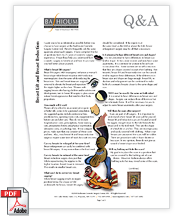Eyelid Surgery
I want you to be as informed as possible before you choose to have surgery at the Bashioum Cosmetic Surgery Center, Ltd. Patients always ask the same questions about each operation. I have compiled this list of questions from my eighteen years of cosmetic surgery experience. I hope that it helps you understand how cosmetic surgery is beneficial and how it can make you feel better about yourself. Please review FAQ Cosmetic Surgery for more information.
- What is eyelid surgery?
- How much will it cost?
- What can I do about my eyelid bags and sagging?
- Will I ever be exactly the same on both sides?
- Will there be scars after surgery?
- What are the risks of eyelid surgery?
- Will this affect my vision?
- How long should I wait after refractive or cataract surgery?
- Will this change the shape of my eyes?
- I have heard about so many bad things on television, is it safe to have eyelid surgery?
- What can you tell me about this new technique that I saw on television?
- Should I stop smoking?
- What other choices do I have?
- How are forehead lift and upper eyelid surgery related?
- What additional procedures can I consider that will enhance the result?
- Am I a good candidate for an eyelid surgery?
- How many times can I have eyelid surgery done?
- What kind of anesthesia will be used?
- How is an eyelid surgery done?
- How long will I be in the operating room ?
What is eyelid surgery?
Eyelid surgery (AKA blepharoplasty, eye tuck, or eye lift) reduces eyelid bags or sagging. Eyelid skin and fat are surgically removed and/or repositioned to rejuvenate eyelid appearance. People with bags of the lower eyelids and/or sagging of the upper eyelids due to aging or sun damage, choose eyelid surgery to give a more youthful, refreshed appearance.
Back to Top
How much will it cost?
Please call my office for an accurate price quote or, better still, come in for a personal consultation. My suggested quotes include professional fees, anesthesia fees, operating room costs, equipment fees, and before and after care. They do not include hospitalization costs, prescriptions, home nursing care, preoperative history and physical examination, laboratory costs, or pathology fees. If you compare prices, make sure that you consider all these costs and fees. Also, most eyelid surgery procedures require some time off work for a safe recovery.
Back to Top
What can I do about my eyelid bags and sagging?
Relaxing skin and bulging eye fat lead to hooding of the upper eyelids and bags of the lower eyelids. Eyelid surgery corrects these changes by removing extra skin while either repositioning or removing extra fat.
Back to Top
Will I ever be exactly the same on both sides?
It is normal for you to have differences in your eyelids. Surgery can reduce these differences but not eliminate them. It will be necessary for you to adjust to some eyelid asymmetry after your surgery.
Back to Top
Will there be scars after surgery?
Scars are part of all surgery. It is important to understand where eyelid surgery scars will be placed. The upper eyelid surgery scar extends from the inner corner of the upper eyelid arcing up along the curvature of the eye socket toward the outer corner and onto the skin of the crow’s feet . The lower eyelid scar extends from the inner corner of the eyelid along the edge of the lid just beneath the eyelashes and onto the skin of the crow’s feet. In young people who require only fat removal, the scar can be hidden in the wet lining (conjunctiva) of the lower eyelid. The length of the scar is determined by how much extra skin is present. These can easily be covered with makeup.
Back to Top
What are the risks of eyelid surgery?
There are risks with any surgery. Infection, excessive bleeding, abnormal scarring, poor healing, slow healing, skin loss, changes in skin sensation, and muscle or nerve injury, although uncommon, can occur with any surgery. Fortunately, most problems that result from such complications are correctable with additional surgery. Pulling down of the lower eyelid, difficulty closing the eyelids, and dryness of the eyes can also occur. Finally, although very rare, blindness has been reported with eyelid surgery. You must understand your risk of complications completely before you choose to have an eyelid surgery.
Back to Top
Will this affect my vision?
Although very rare, blindness can occur whenever surgery is performed near the eyeball. This can be permanent. It is also possible to experience temporary blurring of the vision as a result of swelling and dry eyes. You will not be able to wear contact lenses for one to three weeks after eyelid surgery.
Back to Top
How long should I wait after refractive or cataract surgery?
I suggest you wait six months after these surgeries to allow complete healing. Always consult with your ophthalmologist regarding this as well.
Back to Top
Will this change the shape of my eyes?
Eyelid surgery should not change the shape of your eyelids unless that is your choice. A natural result after eyelid surgery should leave your eyes the same shape as before surgery.
Back to Top
I have heard about so many bad things on television, is it safe to have eyelid surgery?
There are always risks to having eyelid surgery. Serious problems are usually related to excessive surgery and/or undiagnosed medical conditions. Careful attention to high blood pressure, arthritis conditions, and thyroid disease is necessary. I believe eyelid surgery can be done safely with a high degree of patient satisfaction.
Back to Top
What can you tell me about this new technique that I saw on television?
Everyone in the United States wants the latest in medical care. Unfortunately, this is not always the best medical care. At times, media presentations will leave out critical information about potential complications, quality of results, and FDA regulations. I am open-minded when it comes to new technology but I would rather not expose my patients to the newest techniques until they have been proven to be effective and safe. Recent advances in eyelid surgery include fat removal through the wet part of the lower eyelid, repositioning of lower eyelid fat rather than removal, brow lift surgery through upper eyelid incisions, frown line treatment through upper eyelid incisions, cheek lift surgery through lower eyelid incisions, cheek implant placement through lower eyelid incisions, and changing the slant of outer corner the eye. Fat repositioning and fat removal through the wet part of the lower eyelid have proven to be real advances in eyelid surgery.
Back to Top
Should I stop smoking?
For general health reasons, I recommend that all my patients stop smoking. It is clear that smoking increases your risk for developing all sorts of cancers. Breathing problems like emphysema and circulatory problems, including heart attacks, are also linked to smoking. Smoking can increase the risk of coughing after your surgery, which may lead to unwanted bleeding. Finally, the chemicals released from burning tobacco also reduce blood flow, which can result in skin loss during the healing period. Both of these problems can ruin the results of your eyelid surgery and lead to revision surgery. It is always best to stop smoking.
Back to Top
What other choices do I have?
There are other choices when it comes to eyelid surgery. These include forehead lift, skin resurfacing, Botox® injections, Restylane® injections, fat graft injections, acceptance of a deformity, and changes in makeup style. Always understand all your options before having eyelid surgery.
Back to Top
How are forehead lift and upper eyelid surgery related?
A forehead lift will tighten the upper eyelid skin by elevating the eyebrows. When forehead lift is done after upper eyelid surgery, less skin is removed than when it is done before upper eyelid surgery. Care must be taken not to elevate the eyebrows too much after upper eyelid surgery because it can affect your ability to close your eyes. For this reason, I recommend that if you are considering both upper eyelid and forehead lift surgery, have the forehead lift first. Due to the risks of difficulty of closing the eyes and revision surgery, I do not recommend surgery on the upper eyelids and the forehead at the same time.
Back to Top
What additional procedures can I consider that will enhance the result?
Surgeries can be combined to yield dramatic and complimentary results. For safety reasons, I recommend the length of surgery be limited to six hours. Except for liposuction, I suggest no more than one area of the body be treated at the same time. Eyelid surgery is frequently combined with facial rejuvenation surgery (facelift, forehead lift, and skin resurfacing), facial liposuction, facial implants, and nose surgery. If you have weakness or poor elasticity of the lower eyelids (ectropion), this can be corrected at the same time as lower eyelid surgery.
Back to Top
Am I a good candidate for an eyelid surgery?
This is a question that can only be answered after a consultation. Eyelid surgery is suggested to patients with sagging and/or wrinkling skin of the upper or lower eyelids. This may represent hooding of the upper eyelids or bags of the lower eyelids. I feel strongly that eyelid surgery should not be done if high blood pressure (hypertension) is not well controlled, if there is bulging of the eyeball, or if there is severe dryness of the eyes. There are other things to consider including psychiatric conditions, life stress, medical illness, obesity, and motivation. You should be a healthy nonsmoker within twenty pounds of your ideal weight, not going through major life stress (i.e. grieving a death, changing jobs, divorcing), and motivated by internal desires to look better.
Back to Top
How many times can I have eyelid surgery done?
When eyelid surgery is done, extra skin is removed, stretching the remaining tissue. I strongly discourage any sun exposure that would stretch and damage the eyelids. In addition, redoing the surgery may overly tighten the skin, changing the shape of the eyes, or interfering with complete closure of the eyes. For these reasons, I recommend that eyelid surgery only be done once or twice.
Back to Top
What kind of anesthesia will be used?
Most eyelid surgery in my office is completed under local anesthesia that is supplemented with intravenous sedation. It can also be completed under general anesthesia. You have the choice. Patients usually remember little or nothing of the experience.
Back to Top
How is an eyelid surgery done?
Eyelid surgery can be separated into four parts. First, a plan is outlined on your eyelids. Second, the incision is placed on the upper and/or lower eyelid so that the subsequent scar will be inconspicuous and easily covered with makeup. Next, extra fat is either removed (i.e. upper eyelid) or repositioned (i.e. lower eyelid). Muscle is tightened and extra skin is removed. Finally, absorbable stitches are placed to close the incision in the skin.
Back to Top
How long will I be in the operating room?
The length of time it takes to complete eyelid surgery is about one to two hours. It takes longer if both upper and lower eyelid surgeries are done at the same time or if forehead lift is done with lower eyelid surgery. You will spend about four to five hours in my office. Frequently, other surgery is combined with eyelid surgery increasing the time to complete the operation(s). For safety reasons, I limit the maximum time for surgery on each patient to six hours on a given day.
Back to Top






